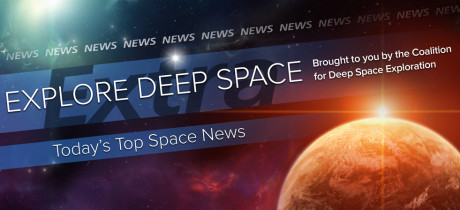In Today’s Deep Space Extra… Historic moon-landing spacecraft hardware to tour U.S. to mark Apollo 11’s 50th anniversary.
Human Deep Space Exploration
The Apollo 11 capsule is going on an American road trip
USA Today (2/22): The Smithsonian Institution plans to take the Apollo 11 capsule “Columbia” on a two year national tour. The tour, entitled “Destination Moon: The Apollo 11 Mission,” will celebrate the 50th anniversary of the historic voyage that launched Neil Armstrong and Buzz Aldrin to the moon’s surface in the Eagle lander. Astronaut Mike Collins orbited the moon in Columbia, during the July 1969 lunar landing.
NASA’s longshot bet on a revolutionary rocket may be about to pay off
Ars Technica (2/23): Former NASA astronaut Franklin Chang-Diaz, who shares the record for the most space launches, forges ahead with the development of a plasma rocket that could greatly accelerate space travel for humans and cargo on deep space missions. Efforts are underway in the lab of his Houston company, Ad Astra, to qualify the hardware for a future spaceflight.
Blackbird Interactive builds NASA’s vision of what a Mars base would look like
Venture Beat (2/23): NASA has turned to the gaming industry to create the tools to visualize a Mars base concept.
Space Science
NASA announces a single star is home to at least 7 earthlike planets
Time (2/22): Just 39 light years from Earth, a small and relative cool star designed Trappist-1, may be home to as many as seven rocky planets orbiting with the habitable zone — a region where water, if present, would be stable as a liquid. Findings, published in the journal Nature, describe the planets as roughly Earth-sized. The discovery is credited to a large team of international astronomers who turned to space as well as Earth-based telescopes for multiple rounds of observation
Here’s what you should know about the newfound TRAPPIST-1 solar system
Washington Post (2/22): The Trappist-1 discovery marks the first time astronauts have detected so many rocky planets circling a single star, one 39 light years away. Small and cool, Trappist-1 is comparable in size to Jupiter. The planets circle quite close to their host star and do not spin on an axis to provide alternating day/night cycles on the planetary surfaces.
Martian mudflats hark back to the time the planet dried out
Cosmos (2/23): Cracked soil studied by NASA’s Mars Curiosity rover in Gale Crater suggests the neighboring planet experienced alternating wet and dry periods more than three billion years ago.
Europa mission enters next development phase
Space News (2/22): Efforts to develop a mission to investigate the habitability of the Jovian moon Europa have reached a milestone, according to NASA. Often called Europa Clipper, the mission would orbit Jupiter and make a series of close passes by the ice covered moon of Jupiter. Key Decision Point B, achieved February 15, allows planners to proceed with the preliminary design phase. Though yet to be costed and provided with a schedule, mission managers will work toward a launch in the 2020s. Scientists believe Europe may host conditions favorable for life.
Low Earth Orbit
After making history in space, Mae Jemison works to prime future scientists
NPR (2/22): Dr. Mae Jemison, the first African-American in space, reflects on the role of women and minorities in science, engineering and space exploration. This weekend, Hidden Figures, a feature movie that tells the story of the role African American woman played in the early days of the Cold War space race, will compete for three academy awards, including best picture.
Commercial to Low Earth Orbit
SpaceX makes good on Space Station delivery a little late
Associated Press via New York Times (2/23): After a day’s delay, SpaceX’s tenth Dragon resupply mission spacecraft rendezvoused with the International Space Station early Thursday. European Space Agency astronaut Thomas Pesquet and NASA’s Shane Kimbough teamed to capture the capsule with its 5,500 pound cargo using the Station’s Canadian robot arm at 5:44 a.m., EST. The capsule, loaded with science experiments as well as crew supplies, is to remain berthed to the Space Station for about one month.
Commercial crew providers remain confident in schedules
Space News (2/22): Prepare for the inaugural launches of astronauts by Boeing and SpaceX in 2018, representatives of the two companies are declaring in response to a recent U.S. Government Accountability Office audit that cautions the flights could be delayed until 2019. Boeing’s Starliner 100 and SpaceX’s crewed Dragon are in development under NASA’s Commercial Crew Program to restore a U.S. human launch capability lost when NASA’s space shuttle fleet was retired in 2011. Boeing and SpaceX are to transport astronauts to and from the International Space Station.
Jeff Bezos’ Blue Origin space venture has plans for big expansion of Seattle-area HQ
Geekwire (2/22): Blue Origin, headquartered in the Seattle, Washington, is expanding; hiring and planning to test fly its New Shepard suborbital spacecraft with astronauts by year’s end.

